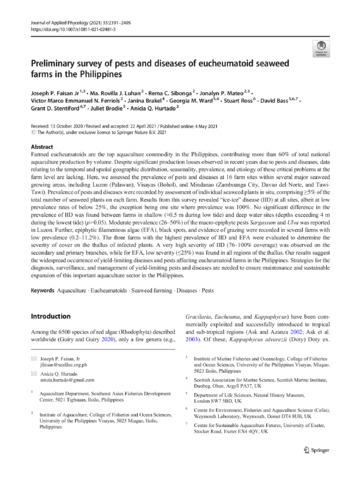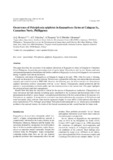Photosynthetic responses of ‘Neosiphonia sp. epiphyte-infected’ and healthy Kappaphycus alvarezii (Rhodophyta) to irradiance, salinity and pH variations
- Global styles
- MLA
- Vancouver
- Elsevier - Harvard
- APA
- Help

View/Open
Date
2016Page views
1,003ASFA keyword
AGROVOC keyword
Taxonomic term
Metadata
Perlihat publikasi penuhCited times in Scopus
64 readers on Mendeley
- Citations
- CrossRef - Citation Indexes: 13
- Policy Citation - Policy Citations: 1
- Scopus - Citation Indexes: 19
- Captures
- Mendeley - Readers: 64
Share
Abstract
Understanding the physiological condition of seaweeds as influenced by biotic and abiotic stress is vital from the perspective of massive expansion and sustainability of seaweed-based industries. The photosynthetic responses ofNeosiphonia sp. epiphyte-infected (INF) and healthy (HEA) Kappaphycus alvarezii under various combinations of irradiance, salinity and pH were studied using photosynthesis-irradiance (P-E) curves. Measurements of algal photosynthetic rates, expressed in terms of amount of oxygen production per fresh weight biomass per unit time (mg O2 g−1 FW h−1), were carried out using the light-dark bottle technique. Neosiphonia-infected K. alvarezii (INF) had lower photosynthetic rates than healthy ones (HEA). Similarities (p > 0.05) in light-saturated photosynthesis rates (Pmax) and significant differences (p < 0.05) in initial slope of curve (α) between INF and HEAK. alvarezii suggest that both samples are adapted to similar light conditions and differs only on photosynthetic efficiency. Low Pmax (0.7–2.0 mg O2 g−1 FW h−1) and high initial saturation irradiances (Ek = 90–519 μmol photons m−2 s−1) of INF seaweeds resulted to their low photosynthetic efficiency (α = 0.002–0.010). Such decline in α is attributed to the epiphyte, as Neosiphonia sp. covered almost the entire surface of K. alvarezii. An increase in chlorophyll-a (35–42.1 vs. 27.7–31.5 μg g−1 FW, HEA) and phycobilin (1.96–2.39 vs. 1.16–1.58 mg g−1 FW, HEA) contents was also observed in INF samples, suggesting acclimation to low-irradiance conditions, as a result of competition for light between the epiphyte and host. Both INF and HEA K. alvarezii also exhibited broad photosynthetic tolerance to short-term changes in irradiance, with no photoinhibition at the highest irradiance of 850 μmol photons m−2 s−1. K. alvarezii had a euryhaline photosynthetic response, with optimum salinity of 35 psu. Photosynthetic rates increased with decreasing pH, revealing K. alvarezii’s ability to modify its photosynthetic affinity for acidic seawater conditions; yet, their underlying mechanism of response to pH shifts still need to be further examined.
Suggested Citation
Borlongan, I. A. G., Luhan, M. R. J., Padilla, P. I. P., & Hurtado, A. Q. (2016). Photosynthetic responses of ‘Neosiphonia sp. epiphyte-infected’ and healthy Kappaphycus alvarezii (Rhodophyta) to irradiance, salinity and pH variations. Journal of Applied Phycology , 28(5), 2891-2902. https://doi.org/10.1007/s10811-016-0833-4
Type
ArticleISSN
0921-8971; 1573-5176Koleksi
- Journal Articles [1249]
Related items
Showing items related by title, author, creator and subject.
-
Preliminary survey of pests and diseases of eucheumatoid seaweed farms in the Philippines
Faisan, Joseph P., Jr. ; Luhan, Maria Rovilla; Sibonga, Rema
; Luhan, Maria Rovilla; Sibonga, Rema  ; Mateo, Jonalyn; Ferriols, Victor Marco Emmanuel; Brakel, Janina; Ward, Georgia M.; Ross, Stuart; Bass, David; Stentiford, Grant; Brodie, Juliet; Hurtado, Anicia Q. (Springer, 2021-05-04)
Farmed eucheumatoids are the top aquaculture commodity in the Philippines, contributing more than 60% of total national aquaculture production by volume. Despite significant production losses observed in recent years due ...
; Mateo, Jonalyn; Ferriols, Victor Marco Emmanuel; Brakel, Janina; Ward, Georgia M.; Ross, Stuart; Bass, David; Stentiford, Grant; Brodie, Juliet; Hurtado, Anicia Q. (Springer, 2021-05-04)
Farmed eucheumatoids are the top aquaculture commodity in the Philippines, contributing more than 60% of total national aquaculture production by volume. Despite significant production losses observed in recent years due ...
-
Occurrence of Polysiphonia epiphytes in Kappaphycus farms at Calaguas Is., Camarines Norte, Phillippines
Hurtado, A. Q.; Critchley, A. T.; Trespoey, A.; Lhonneur, G. Bleicher (Springer Verlag, 2006)This paper describes the occurrence of an epiphyte infestation of Kappaphycus farms in Calaguas Is. Camarines Norte, Philippines. In particular, percentage cover of ‘goose bump’-Polysiphonia and ‘ice-ice’ disease, and some ...
-
A preliminary summary on Kappaphycus farming and the impact of epiphytes
Critchley, A. T.; Largo, D.; Wee, W.; Bleicher L'honneur, G.; Hurtado, A. Q.; Schubert, J. (Japanese Society of Phycology, 2004)The read seaweed Kappaphycus alvarezii (Doty) Doty ex. P.C. Silva, commonly called "cottonii" in the processing industry, is used as raw material for the production of the hydrocolloid kappa carrageenan. Through biotechnological ...






